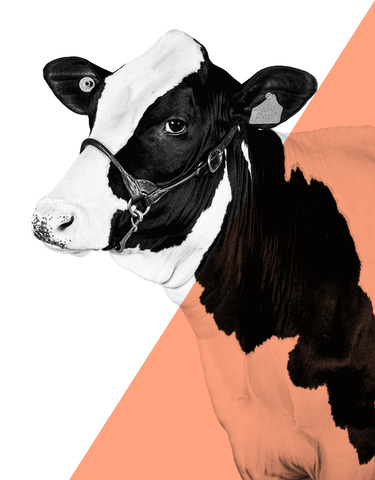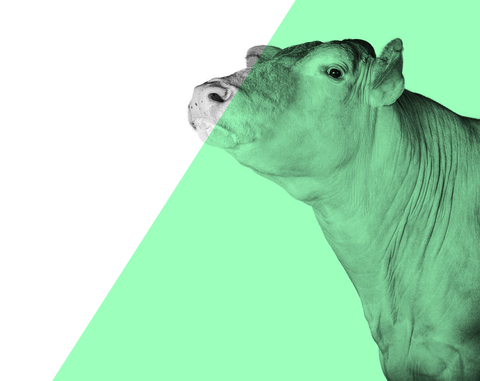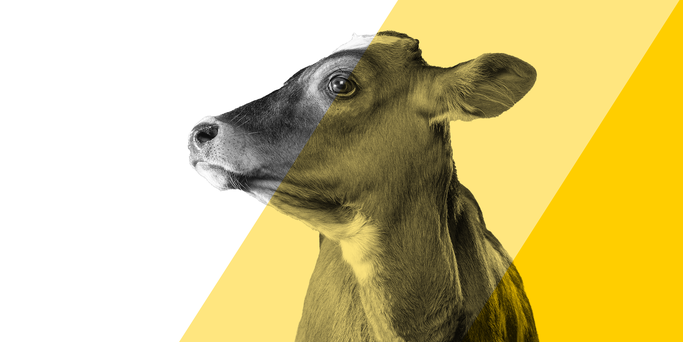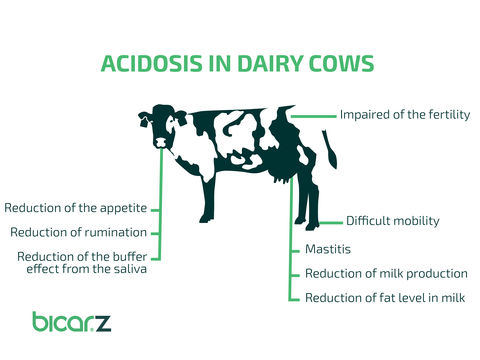What is rumen acidosis ?
Rumen acidosis, or ruminal acidosis, is a disturbance in the balance of the rumen of the cow. The rumen is home to active micro-organisms (ruminal microbiota) that digest fibre-rich feed and convert it into nutrients such as volatile fatty acids and protein. For efficient milk production, it is therefore important to keep the rumen healthy. Acidosis in dairy cows is a threat to milk production.
Bicarbonate is a natural buffer for rumen acidosis
In a healthy rumen, there is a balance. The digestion process is responsible for the production of volatile fatty acids in the rumen. Absorbed into the bloodstream after passing through the rumen wall, they are an important source of energy for the cow. However, an excess of volatile fatty acids in the rumen causes rumen acidosis, which is extremely harmful to the rumen microbiota. This effect is compensated for by the cow's saliva, which naturally contains bicarbonate, which acts as a buffer. When the animal's saliva is unable to compensate for the effects of rumen acidosis, it is important to feed sodium bicarbonate to cows.
Extreme sensitivity of the cow's rumen
Rumen acidosis occurs when the balance between the production and assimilation of fatty acids is disturbed. Thus, rumen acidosis is always present. In fact, any change in the ration involves potential risks that can disturb the rumen balance. Rumen acidosis can be prevented by appropriate feed measures.
Rumen acidosis symptoms
Clinical symptoms
Rumen acidosis most often occurs in a sub-clinical or sub-acute form called SARA (for Sub Acute Ruminal Acidosis). Rumen acidosis manifests itself in different ways:
- A decrease and irregularity of appetite and feed efficiency
- Acidosis in dairy cows causes a decrease in milk production (-2.7 kg Plaizier 2009) and in butter fat content (-3 g/kg Plaizier 2009)
- Reduced rumination (less than 50% of cows ruminate at rest)
- Intestinal acidosis, with fibrin in the dung
- Undigested dung
- Various infections: liver abscesses and septic consequences
- Laminitis problems
- Poor general condition, weight loss, licking urine and walls, the animal may drool excessively during rumination and regurgitates
What causes rumen acidosis?
The pH drops in the rumen due to the accumulation of acids, mainly Volatile Fatty Acids (VFA) and lactic acid. This accumulation is due to several phenomena that can accumulate.
Rumen acidosis is a permanent threat to high producing dairy cows but, today, it is possible to prevent the disease by using the risk-acidosis calculator. The risk is increased in the following cases:
- Too much acid is produced in the rumen due to too high or too rapid ingestion, too much fermentable feed (e.g. cereals) or in too large quantities,
- Too fast transitions: ideally transitions should be spread over 3 to 6 weeks,
- Insufficient rumination and salivation, reducing the return of salivary buffers due to lack of effective fibre and sorting by the animals,
- Environmental factors negatively impacting rumen pH: lack of time spent ruminating, lack of comfort, heat, stress.
In order to provide a lot of energy to highly productive dairy cows, the ration of these animals contains a large quantity of rapidly fermentable carbohydrates (concentrated feed) to the detriment of cellulose (fibrous products are less rich in energy).
The vicious circle of acidosis
When the animal ingests concentrated feed, Volatile Fatty Acids are produced faster than they are absorbed by the rumen mucosa or neutralized by the bicarbonate of saliva, resulting in acidosis. In addition, low-fibre rations do not sufficiently stimulate rumination and salivation, preventing the cow from naturally restoring a normal ruminal pH (6-6.4). As a result, the risk of acidosis is even higher.
During the early lactation phase, cows are sensitive to rumen acidosis. The rumen must adapt to large changes in the ration given to the animal.
Cows are very sensitive to heat stress. As soon as the temperature is above 20 degrees Celsius, and more precisely as from 68 of the Temperature Humidity Index or THI, an index that takes into account not only the temperature but also the hygrometry.
Grazing cows are subject to significant changes throughout the season because the nutritional value of grass varies over time. The same applies, for example, to the dry matter intake of grass in combination with the consumption of concentrated feed.
Nutritional value can vary considerably from one silage forage to another.
How do you detect acidosis when cows are grazing?
Acidosis is quite common when cattle are put out to pasture and is a pathology that is difficult to detect. Several studies and testimonials analyze the causes of acidosis in beef cattle. Here are a few signs that can help identify animals suffering from acidosis:
- Reduced milk fat or butterfat is the first warning sign,
- The risk of lameness is increased ,
- Milk production is declining,
- Dung is fluid, yellowish in colour and shows signs of incomplete digestion (undigested fibre),
- Reduced chewing (the optimal value is 50 to 70 chewing movements per rumination bowl),
- Reduced and irregular fodder consumption. In case of acute rumen acidosis, the animal stops feeding completely.
How can rumen acidosis be prevented?
Acidosis can be prevented by adapting the animal's diet.
High-producing cows need a ration containing enough energy and protein for milk production, but also enough fibre for optimal digestion. Several studies and testimonials show how sodium bicarbonate supplementation can prevent rumen acidosis. The use of sodium bicarbonate for cows as a standard ration ingredient allows the composition of a safe ration for a healthy rumen.
This natural buffer creates a balance between the production and assimilation of volatile fatty acids in the rumen. The daily dosage of Bicar®Z per animal is 250 g, to be added to the daily feed ration.
4 extra litres of milk per cow
The Bicar®Z team has carried out various studies in different countries and these have shown that the addition of 250 to 300 g of Bicar®Z in the ration or on hand resulted in 16.5% additional milk. Each cow produced between 2.4 and 4 extra liters per day.
What are the daily doses to be administered to your animals?
If the cow receives less fibre, she chews less and therefore produces less saliva. Saliva contains bicarbonate, a buffer that naturally neutralizes acidity peaks in the rumen.
A healthy cow ruminates for seven to nine hours a day, preferably in a lying position. So stall size and comfort are important. If stalls are too short, rumination time is affected. If rumination is too low, the risk of rumen acidosis increases.
If you use a full or semi-full ration, make sure the cow cannot sort through the different feeds. Cows have preferences (fine particles and high energy). As a result, some cows are at higher risk of rumen acidosis.
Regularly check that the ration is well mixed. Ration sieving is a good way to achieve this. In principle, refusals should resemble the initial ration as closely as possible.
For optimal digestion of the ration, it is ideal to regularly cut the corn into pieces of about 10 to 15 millimetres in length. Make sure that the kernels are well broken up.
Drinking water, which is available without restriction, is essential for optimal use of the ration and a healthy rumen.
What are the consequences of acidosis?
Loss of hundreds of Euros per cow
Rumen acidosis is very expensive. One study shows that a cow with subclinical acidosis produces an average of 2.7 kilograms less milk per day. Moreover, this milk is less rich in fat and protein (-0.3 and -0.12% respectively). Various studies have shown that rumen acidosis is very common: 9 to 27% of the herd suffers from subclinical rumen acidosis, which represents a cost to the farmer of up to several hundred euros per cow.
According to a study carried out by Orffa, distributor of Bicar®Z for cows in Germany, Belgium, Denmark and the Netherlands, the risk of acidosis can cost the equivalent of 210 euros per cow per year.
Long-term effects due to health problems
In addition, acidosis has long-term effects as the cow becomes more susceptible to diseases such as laminitis, sole ulcers and reduced fertility.
Acidosis can cause laminitis.
The disturbance of ruminal metabolism during acidosis, generates the production of amines and vasoactive toxins that cross the rumen walls and will cause vasoconstriction in the foot, reducing blood perfusion and causing anoxia, necrosis, discoloration of the horn and haemorrhages in the foot; as the blood does not circulate well in the foot, it stagnates above the hoof causing congestion, one of the most visible signs of laminitis.
The consequences of laminitis, also called laminitis, are serious:
- difficulty in moving, therefore reduced ingestion, bad heat, poor general condition,
- injuries and other trauma because the animal is not lying properly
- the increase in slaughter, miscellaneous costs, etc

Pigs and acidosis
When fed an energy-rich feed, pigs metabolize feed very quickly and the acid-base balance may be disturbed, causing metabolic acidosis.

Heat Stress
When the temperature rises above 20°, cows, pigs, and hens become "stressed", resulting in decreased productivity, health issues and reduced well-being.




